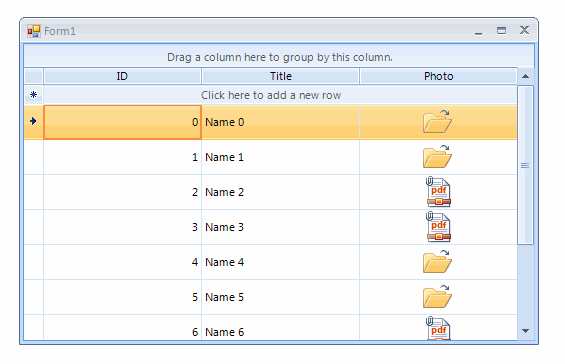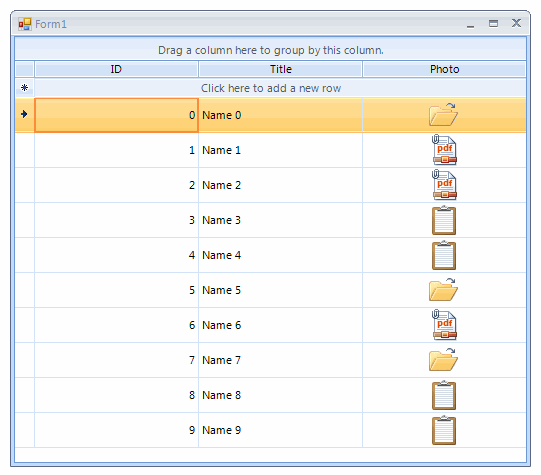Grouping by GridViewImageColumn
| Date Posted | Product | Author |
|---|---|---|
| May 09, 2014 | RadGridView | Desislava Yordanova |
How To
By default, RadGridView does not support grouping by GridViewImageColumn functionality. This article demonstrates how to implement such a behavior.
Solution
1. First, let’s populate the RadGridView with data. For this purpose, we will start with creating a sample class MyObject, which have Photo property of type Image.
List<Image> images = new List<Image>()
{
Properties.Resources.open,
Properties.Resources.paste,
Properties.Resources.pdf
};
public Form1()
{
InitializeComponent();
Random rand = new Random();
List<MyObject> list = new List<MyObject>() { };
for (int i = 0; i < 10; i++)
{
list.Add(new MyObject(rand.Next(0, 4), "Name " + i, images[rand.Next(0, images.Count)]));
}
radGridView1.DataSource = list;
radGridView1.AutoSizeRows = true;
radGridView1.AutoSizeColumnsMode = GridViewAutoSizeColumnsMode.Fill;
}
Private images As New List(Of Image)() From { _
My.Resources.open, _
My.Resources.paste, _
My.Resources.pdf _
}
Public Sub New()
InitializeComponent()
Dim rand As New Random()
Dim list As New List(Of MyObject)()
For i As Integer = 0 To 9
list.Add(New MyObject(rand.[Next](0, 4), "Name " & i, images(rand.[Next](0, images.Count))))
Next
RadGridView1.DataSource = list
RadGridView1.AutoSizeRows = True
RadGridView1.AutoSizeColumnsMode = GridViewAutoSizeColumnsMode.Fill
End Sub
The custom business object:
public class MyObject
{
public int ID { get; set; }
public string Title { get; set; }
public Image Photo { get; set; }
public MyObject(int iD, string title, Image photo)
{
this.ID = iD;
this.Title = title;
this.Photo = photo;
}
}
Public Class MyObject
Public Property ID() As Integer
Get
Return m_ID
End Get
Set(value As Integer)
m_ID = value
End Set
End Property
Private m_ID As Integer
Public Property Title() As String
Get
Return m_Title
End Get
Set(value As String)
m_Title = value
End Set
End Property
Private m_Title As String
Public Property Photo() As Image
Get
Return m_Photo
End Get
Set(value As Image)
m_Photo = value
End Set
End Property
Private m_Photo As Image
Public Sub New(iD As Integer, title As String, photo AsImage)
Me.ID = iD
Me.Title = title
Me.Photo = photo
End Sub
End Class
You will notice that you are not allowed to drag the GridViewImageColumn’s header and drop it over the “Drag a column here to group by this column” area.

2. In order to enable drag and drop functionality for the GridViewImageColumn’s header over the GroupPanelElement, it is necessary to use the RadDragDropService. Subscribe for its PreviewDragStart event to start the RadDragDropService if you are dragging a GridHeaderCellElement. Use the PreviewDragOver event to allow dropping over the GroupPanelElement:
public Form1()
{
InitializeComponent();
//populate the grid with data
RadDragDropService svc =this.radGridView1.GridViewElement.GetService<RadDragDropService>();
svc.PreviewDragStart += svc_PreviewDragStart;
svc.PreviewDragOver += svc_PreviewDragOver;
radGridView1.GroupByChanged += radGridView1_GroupByChanged;
radGridView1.EnableCustomGrouping = true;
radGridView1.CustomGrouping += radGridView1_CustomGrouping;
radGridView1.GroupSummaryEvaluate += radGridView1_GroupSummaryEvaluate;
}
private void svc_PreviewDragStart(object sender, PreviewDragStartEventArgs e)
{
SnapshotDragItem dragged = e.DragInstance asSnapshotDragItem;
if (dragged != null && dragged.Item isGridHeaderCellElement)
{
e.CanStart = true;
}
}
private void svc_PreviewDragOver(object sender, RadDragOverEventArgs e)
{
SnapshotDragItem dragged = e.DragInstance asSnapshotDragItem;
if (dragged != null && dragged.Item isGridHeaderCellElement)
{
e.CanDrop = e.HitTarget is GroupPanelElement;
}
}
Public Sub New()
InitializeComponent()
'populate the grid with data
Dim svc As RadDragDropService =Me.RadGridView1.GridViewElement.GetService(Of RadDragDropService)()
AddHandler svc.PreviewDragStart, AddressOfsvc_PreviewDragStart
AddHandler svc.PreviewDragOver, AddressOfsvc_PreviewDragOver
AddHandler RadGridView1.GroupByChanged, AddressOfradGridView1_GroupByChanged
RadGridView1.EnableCustomGrouping = True
AddHandler RadGridView1.CustomGrouping, AddressOfradGridView1_CustomGrouping
AddHandler RadGridView1.GroupSummaryEvaluate, AddressOfradGridView1_GroupSummaryEvaluate
End Sub
Private Sub svc_PreviewDragStart(sender As Object, e AsPreviewDragStartEventArgs)
Dim dragged As SnapshotDragItem = TryCast(e.DragInstance, SnapshotDragItem)
If dragged IsNot Nothing AndAlso TypeOf dragged.Item IsGridHeaderCellElement Then
e.CanStart = True
End If
End Sub
Private Sub svc_PreviewDragOver(sender As Object, e AsRadDragOverEventArgs)
Dim dragged As SnapshotDragItem = TryCast(e.DragInstance, SnapshotDragItem)
If dragged IsNot Nothing AndAlso TypeOf dragged.Item IsGridHeaderCellElement Then
e.CanDrop = TypeOf e.HitTarget Is GroupPanelElement
End If
End Sub
3. Use the GroupByChanged event to display the GroupFieldElement.RemoveButton
private void radGridView1_GroupByChanged(object sender, GridViewCollectionChangedEventArgs e)
{
if(this.radGridView1.GridViewElement.GroupPanelElement.PanelContainer.Children != null &&
this.radGridView1.GridViewElement.GroupPanelElement.PanelContainer.Children.Count > 0)
{
TemplateGroupsElement templateGroupsElement = radGridView1.GridViewElement.GroupPanelElement.PanelContainer.Children[0] as TemplateGroupsElement;
if (templateGroupsElement != null)
{
foreach (GroupElement groupElement intemplateGroupsElement.GroupElements)
{
foreach (GroupFieldElement groupFieldsElement in groupElement.GroupingFieldElements)
{
if(groupFieldsElement.RemoveButton.Visibility != ElementVisibility.Visible)
{
groupFieldsElement.RemoveButton.Visibility = ElementVisibility.Visible;
}
}
}
}
}
}
Private Sub radGridView1_GroupByChanged(sender As Object, e AsGridViewCollectionChangedEventArgs)
IfMe.RadGridView1.GridViewElement.GroupPanelElement.PanelContainer.Children IsNot Nothing AndAlso _
Me.RadGridView1.GridViewElement.GroupPanelElement.PanelContainer.Children.Count > 0 Then
Dim templateGroupsElement As TemplateGroupsElement = TryCast(RadGridView1.GridViewElement.GroupPanelElement.PanelContainer.Children(0), TemplateGroupsElement)
If templateGroupsElement IsNot Nothing Then
For Each groupElement As GroupElement IntemplateGroupsElement.GroupElements
For Each groupFieldsElement AsGroupFieldElement In groupElement.GroupingFieldElements
IfgroupFieldsElement.RemoveButton.Visibility <> ElementVisibility.Visible Then
groupFieldsElement.RemoveButton.Visibility = ElementVisibility.Visible
End If
Next
Next
End If
End If
End Sub
4. Now, we need to implement the logic for grouping the rows. We will use the custom grouping functionality of the RadGridView. Set the EnableCustomGrouping property to true and subscribe to the CustomGrouping event, where we will group rows by image name:
private void radGridView1_CustomGrouping(object sender, GridViewCustomGroupingEventArgs e)
{
if (this.UseDefaultGrouping(e.Level))
{
e.Handled = false;
return;
}
Image photo = e.Row.Cells["Photo"].Value as Image;
int index = images.IndexOf(photo);
switch (index)
{
case 0:
e.GroupKey = "open";
break;
case 1:
e.GroupKey = "paste";
break;
case 2:
e.GroupKey = "pdf";
break;
default:
e.GroupKey = "Other image";
break;
}
}
private bool UseDefaultGrouping(int level)
{
GroupDescriptor groupDescriptor =this.radGridView1.GroupDescriptors[level];
for (int i = 0; i < groupDescriptor.GroupNames.Count; i++)
{
if(groupDescriptor.GroupNames[i].PropertyName.Equals("Photo", StringComparison.InvariantCultureIgnoreCase))
{
return false;
}
}
return true;
}
Private Sub radGridView1_CustomGrouping(sender As Object, e AsGridViewCustomGroupingEventArgs)
If Me.UseDefaultGrouping(e.Level) Then
e.Handled = False
Return
End If
Dim photo As Image = TryCast(e.Row.Cells("Photo").Value, Image)
Dim index As Integer = images.IndexOf(photo)
Select Case index
Case 0
e.GroupKey = "open"
Exit Select
Case 1
e.GroupKey = "paste"
Exit Select
Case 2
e.GroupKey = "pdf"
Exit Select
Case Else
e.GroupKey = "Other image"
Exit Select
End Select
End Sub
Private Function UseDefaultGrouping(level As Integer) As Boolean
Dim groupDescriptor AsTelerik.WinControls.Data.GroupDescriptor =Me.RadGridView1.GroupDescriptors(level)
For i As Integer = 0 To groupDescriptor.GroupNames.Count - 1
IfgroupDescriptor.GroupNames(i).PropertyName.Equals("Photo", StringComparison.InvariantCultureIgnoreCase) Then
Return False
End If
Next
Return True
End Function
5. The last thing we need to do is to subscribe to the GroupSummaryEvaluate event and construct the desired string for the group’s title:
private void radGridView1_GroupSummaryEvaluate(object sender, GroupSummaryEvaluationEventArgs e)
{
if (this.UseDefaultGrouping(e.Group.Level))
{
return;
}
if (e.Value == null)
{
e.FormatString = "Photo \"" + e.Group.Key.ToString() + "\"";
}
}
Private Sub radGridView1_GroupSummaryEvaluate(sender As Object, e As GroupSummaryEvaluationEventArgs)
If Me.UseDefaultGrouping(e.Group.Level) Then
Return
End If
If e.Value Is Nothing Then
e.FormatString = "Photo """ + e.Group.Key.ToString() + """"
End If
End Sub

A complete solution in C# and VB.NET can be found here.